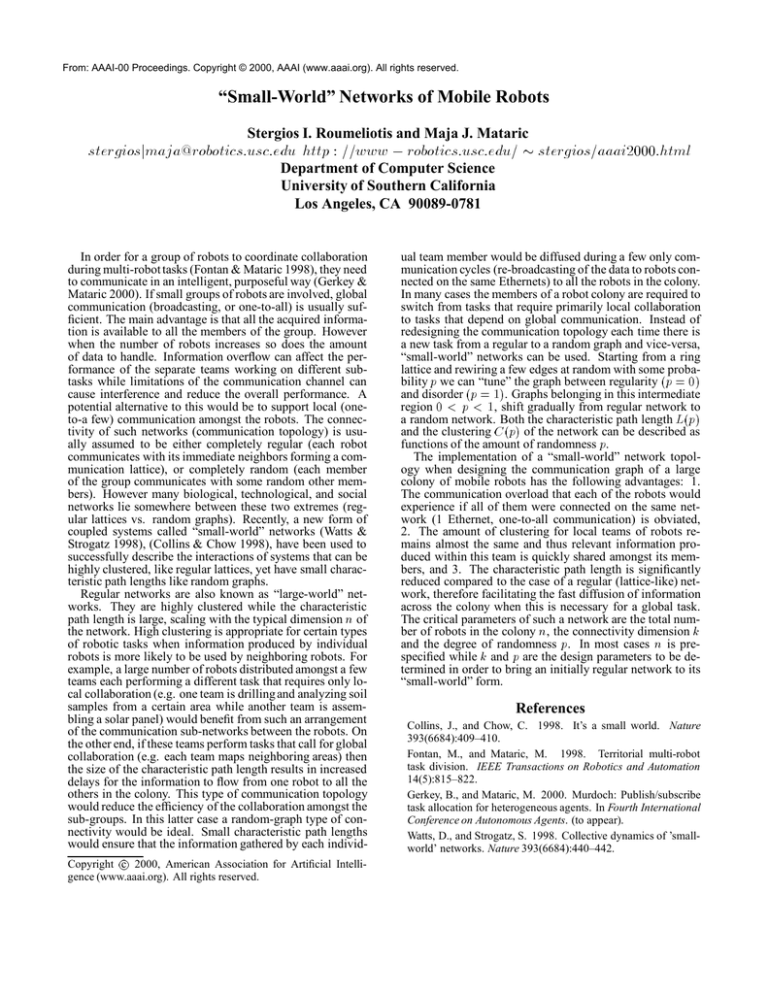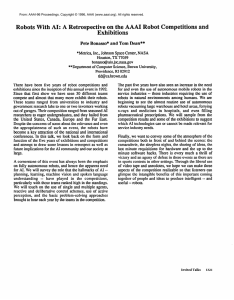
From: AAAI-00 Proceedings. Copyright © 2000, AAAI (www.aaai.org). All rights reserved.
“Small-World” Networks of Mobile Robots
Stergios I. Roumeliotis and Maja J. Mataric
stergiosjmaja@robotics:usc:edu http : ==www , robotics:usc:edu= stergios=aaai2000:html
Department of Computer Science
University of Southern California
Los Angeles, CA 90089-0781
In order for a group of robots to coordinate collaboration
during multi-robot tasks (Fontan & Mataric 1998), they need
to communicate in an intelligent, purposeful way (Gerkey &
Mataric 2000). If small groups of robots are involved, global
communication (broadcasting, or one-to-all) is usually sufficient. The main advantage is that all the acquired information is available to all the members of the group. However
when the number of robots increases so does the amount
of data to handle. Information overflow can affect the performance of the separate teams working on different subtasks while limitations of the communication channel can
cause interference and reduce the overall performance. A
potential alternative to this would be to support local (oneto-a few) communication amongst the robots. The connectivity of such networks (communication topology) is usually assumed to be either completely regular (each robot
communicates with its immediate neighbors forming a communication lattice), or completely random (each member
of the group communicates with some random other members). However many biological, technological, and social
networks lie somewhere between these two extremes (regular lattices vs. random graphs). Recently, a new form of
coupled systems called “small-world” networks (Watts &
Strogatz 1998), (Collins & Chow 1998), have been used to
successfully describe the interactions of systems that can be
highly clustered, like regular lattices, yet have small characteristic path lengths like random graphs.
Regular networks are also known as “large-world” networks. They are highly clustered while the characteristic
path length is large, scaling with the typical dimension n of
the network. High clustering is appropriate for certain types
of robotic tasks when information produced by individual
robots is more likely to be used by neighboring robots. For
example, a large number of robots distributed amongst a few
teams each performing a different task that requires only local collaboration (e.g. one team is drilling and analyzing soil
samples from a certain area while another team is assembling a solar panel) would benefit from such an arrangement
of the communication sub-networks between the robots. On
the other end, if these teams perform tasks that call for global
collaboration (e.g. each team maps neighboring areas) then
the size of the characteristic path length results in increased
delays for the information to flow from one robot to all the
others in the colony. This type of communication topology
would reduce the efficiency of the collaboration amongst the
sub-groups. In this latter case a random-graph type of connectivity would be ideal. Small characteristic path lengths
would ensure that the information gathered by each individ-
Copyright c 2000, American Association for Artificial Intelligence (www.aaai.org). All rights reserved.
ual team member would be diffused during a few only communication cycles (re-broadcasting of the data to robots connected on the same Ethernets) to all the robots in the colony.
In many cases the members of a robot colony are required to
switch from tasks that require primarily local collaboration
to tasks that depend on global communication. Instead of
redesigning the communication topology each time there is
a new task from a regular to a random graph and vice-versa,
“small-world” networks can be used. Starting from a ring
lattice and rewiring a few edges at random with some probability p we can “tune” the graph between regularity (p = 0)
and disorder (p = 1). Graphs belonging in this intermediate
region 0 < p < 1, shift gradually from regular network to
a random network. Both the characteristic path length L(p)
and the clustering C (p) of the network can be described as
functions of the amount of randomness p.
The implementation of a “small-world” network topology when designing the communication graph of a large
colony of mobile robots has the following advantages: 1.
The communication overload that each of the robots would
experience if all of them were connected on the same network (1 Ethernet, one-to-all communication) is obviated,
2. The amount of clustering for local teams of robots remains almost the same and thus relevant information produced within this team is quickly shared amongst its members, and 3. The characteristic path length is significantly
reduced compared to the case of a regular (lattice-like) network, therefore facilitating the fast diffusion of information
across the colony when this is necessary for a global task.
The critical parameters of such a network are the total number of robots in the colony n, the connectivity dimension k
and the degree of randomness p. In most cases n is prespecified while k and p are the design parameters to be determined in order to bring an initially regular network to its
“small-world” form.
References
Collins, J., and Chow, C. 1998. It’s a small world. Nature
393(6684):409–410.
Fontan, M., and Mataric, M. 1998. Territorial multi-robot
task division. IEEE Transactions on Robotics and Automation
14(5):815–822.
Gerkey, B., and Mataric, M. 2000. Murdoch: Publish/subscribe
task allocation for heterogeneous agents. In Fourth International
Conference on Autonomous Agents. (to appear).
Watts, D., and Strogatz, S. 1998. Collective dynamics of ’smallworld’ networks. Nature 393(6684):440–442.



